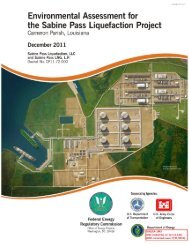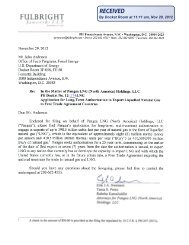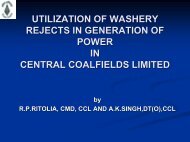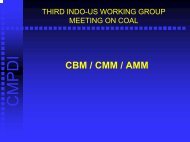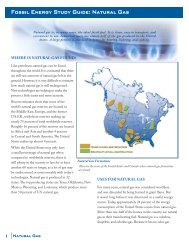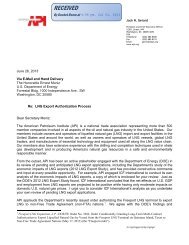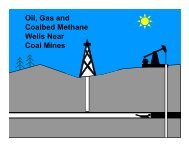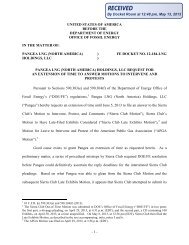Coal Combustion Waste Management at - DOE - Fossil Energy ...
Coal Combustion Waste Management at - DOE - Fossil Energy ...
Coal Combustion Waste Management at - DOE - Fossil Energy ...
Create successful ePaper yourself
Turn your PDF publications into a flip-book with our unique Google optimized e-Paper software.
1<br />
1 INTRODUCTION<br />
1.1 DESCRIPTION OF COAL COMBUSTION WASTES<br />
<strong>Coal</strong> is fired in boilers to he<strong>at</strong> w<strong>at</strong>er in order to gener<strong>at</strong>e high-pressure steam, which in<br />
turn drives gener<strong>at</strong>ors th<strong>at</strong> produce electricity. Electric utilities generally use pulverized coal<br />
boilers, where the coal is crushed to fine particles and blown into the boiler furnace for<br />
combustion. Another type of furnace, used mostly by smaller power gener<strong>at</strong>ors, is the fluidized<br />
bed, which can burn coal of poorer quality or grade and be used for the economical production of<br />
electricity. The uncombusted residue is called coal combustion waste (CCW), coal combustion<br />
by-product (CCB), or coal combustion residue (CCR).<br />
CCWs can be classified as large-volume CCWs and low-volume CCWs. The largevolume<br />
CCWs include fly ash, bottom ash, boiler slag, and flue gas emission control (or flue gas<br />
desulfuriz<strong>at</strong>ion [FGD]) waste. Fly ash is a silt-sized residue (typically between 10 and 100 μm),<br />
composed mainly of amorphous spherical particles, th<strong>at</strong> is transported from the combustion<br />
chamber by exhaust gases and collected by particul<strong>at</strong>e emission control devices before entering<br />
the boiler stack. Bottom ash is a dry, coarse m<strong>at</strong>erial with sintered and agglomer<strong>at</strong>ed amorphous<br />
particles taken from the bottom of the boiler furnace either in its dry form or as a slurry (via the<br />
addition of w<strong>at</strong>er). Boiler slag is also taken from the bottom of the furnace, but emerges in a<br />
molten form; it is usually quenched immedi<strong>at</strong>ely in w<strong>at</strong>er and forms large, glassy pellets. Flue<br />
gas desulfuriz<strong>at</strong>ion residues are gener<strong>at</strong>ed by units th<strong>at</strong> remove sulfur dioxide (SO2) from flue<br />
gas. “Wet” FGD systems are found most frequently <strong>at</strong> large coal-burning utilities; these systems<br />
are installed downstream of the particul<strong>at</strong>e control devices and produce residues th<strong>at</strong> consist<br />
mainly of calcium sulf<strong>at</strong>e or calcium sulfite salts. However, a small but growing percentage of<br />
FGD residues come from “dry” FGD systems or fluidized bed combustion (FBC) systems th<strong>at</strong><br />
remove sulfur upstream of the particul<strong>at</strong>e control devices; therefore, these “FGD residues” are<br />
inseparable mixtures of fly ash, bottom ash, and calcium sulf<strong>at</strong>es/sulfites. Fly ash and “wet”<br />
FGD comprise the largest quantity of these four waste types.<br />
Low-volume CCWs result from supporting processes th<strong>at</strong> are ancillary to the combustion<br />
and power gener<strong>at</strong>ion processes. They include the following:<br />
<strong>Coal</strong> pile runoff,<br />
<strong>Coal</strong> mill rejects/pyrites,<br />
Boiler blowdown,<br />
Cooling tower blowdown and sludge,<br />
W<strong>at</strong>er tre<strong>at</strong>ment sludge,<br />
Regener<strong>at</strong>ion waste streams,



